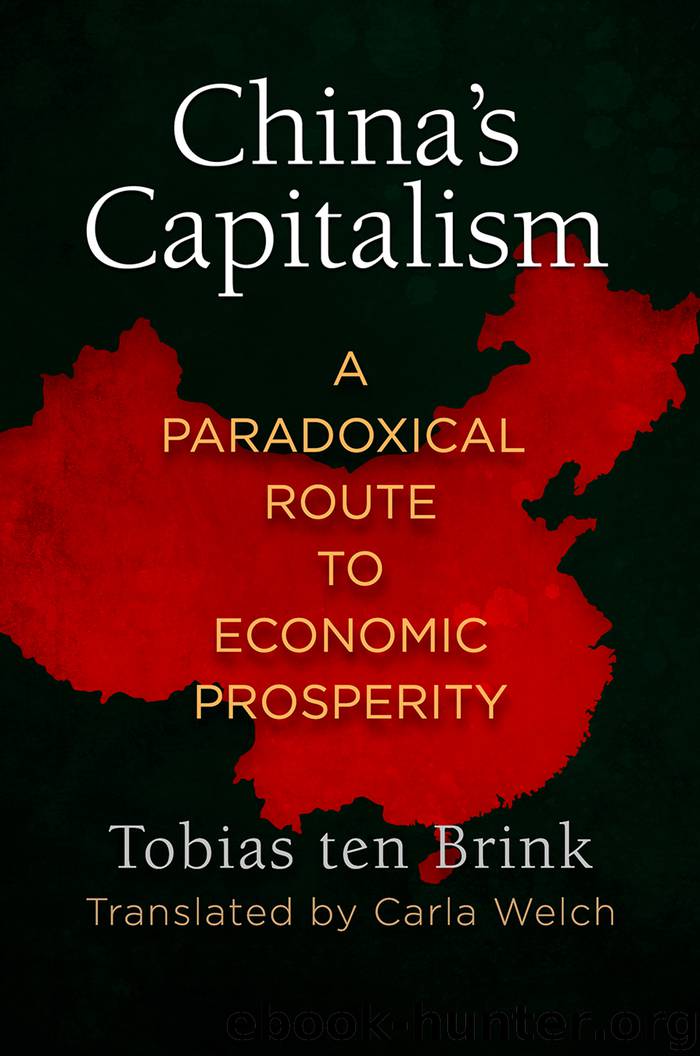China's Capitalism by Tobias ten Brink

Author:Tobias ten Brink
Language: eng
Format: epub
Publisher: University of Pennsylvania Press, Inc.
Published: 2019-06-03T16:00:00+00:00
Figure 1. Retail sales, 2007–16. Source: NBS 2016.
Figure 2. Rise in household consumption. Source: NBS 2015b.
As demonstrated above, the problem of underconsumption has declined somewhat since 2010 because both the increase in disposable income and improvements in social security systems have resulted in an improved consumer climate. Accordingly, the International Monetary Fund (IMF) expects a drop in the savings rate from 48 percent to 42 percent between 2016 and 2021 (IMF 2016, 12).
Interim Conclusion
This chapter revealed that the public-private organization of the Chinese economy created, into the 2010s, fertile ground for implementing efficient corporate strategies. At the same time, over a long period, this also contributed to social cohesion. The process of capitalist modernization could be regulated in the interests of the prevailing alliance of economic and political elites—here the notion of “regulation for competition” (Obinger et al. 2010) via state institutions, a concept we are also familiar with from Western societies, applies.
However, this stability has been called into question. Although the public-private networks underlying the Chinese economy facilitate a high degree of particularistic coordination, the growth model has its limitations (also see L. Chen and Naughton 2017). In the PRC, we can identify paradoxes of prosperity that serve to undermine the stability of Chinese-style development.
In order to attenuate the effects of capitalist modernization, the Chinese central government has been pushing for a comprehensive rebalancing of the economy. However, various factors have presented major hurdles along the way: first, owing to the persisting dependency on an unstable global economy and transnational value chains, the low-wage regime was upheld. Domestic and international companies had and continue to have a significant interest in the competitive edge associated with low wages and taxes, and local governments are all too often prepared to accommodate this interest. Second, there used to be and still is a clear propensity to overinvest. Moreover, an expansive monetary policy enabled borrowers to purchase land and property, as well as shares and other types of financial product. The acquisition of assets like this created speculative bubbles. Although monetary policy decision makers are attempting to prevent the economy from overheating, here the limitations of national interventions in volatile markets are obvious. Inflationary trends could, in turn, undermine the government’s social policy measures because an increase in food prices generally has a more negative impact on poorer families than on wealthier ones.
A countertrend that is advantageous for the government is that the thriving domestic markets have so far prevented a more serious downturn in China. However, as will also be shown in the following section, despite its extensive regulatory capacity, the Chinese government has failed to gain full control over the country’s domestic competition and the associated high-risk growth and finance policies pursued by companies and local governments. To a certain extent, the interests of key groups within the local government apparatus, in the corporate sector, and in the financial system undermine the central government’s efforts. The country’s overinvestment tendencies initially appear to resemble a typical capitalist crisis mechanism. However, the policies
Download
This site does not store any files on its server. We only index and link to content provided by other sites. Please contact the content providers to delete copyright contents if any and email us, we'll remove relevant links or contents immediately.
| Arms Control | Diplomacy |
| Security | Trades & Tariffs |
| Treaties | African |
| Asian | Australian & Oceanian |
| Canadian | Caribbean & Latin American |
| European | Middle Eastern |
| Russian & Former Soviet Union |
The Secret History by Donna Tartt(18934)
The Social Justice Warrior Handbook by Lisa De Pasquale(12162)
Thirteen Reasons Why by Jay Asher(8831)
This Is How You Lose Her by Junot Diaz(6827)
Weapons of Math Destruction by Cathy O'Neil(6202)
Zero to One by Peter Thiel(5724)
Beartown by Fredrik Backman(5662)
The Myth of the Strong Leader by Archie Brown(5451)
The Fire Next Time by James Baldwin(5373)
How Democracies Die by Steven Levitsky & Daniel Ziblatt(5168)
Promise Me, Dad by Joe Biden(5109)
Stone's Rules by Roger Stone(5048)
A Higher Loyalty: Truth, Lies, and Leadership by James Comey(4901)
100 Deadly Skills by Clint Emerson(4872)
Rise and Kill First by Ronen Bergman(4735)
Secrecy World by Jake Bernstein(4696)
The David Icke Guide to the Global Conspiracy (and how to end it) by David Icke(4652)
The Farm by Tom Rob Smith(4462)
The Doomsday Machine by Daniel Ellsberg(4445)
